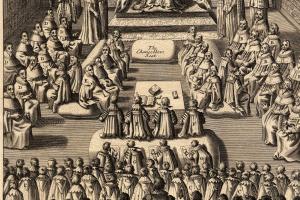1586
Alternative title
Summoned
Assembled
Dissolved
Session
Dates
Long description
Elizabeth refused to attend the state opening of her sixth Parliament, summoned as it was with the sole purpose of condemning her cousin Mary Stuart, Queen of Scots, who had been a prisoner in England since 1568. The 1584-5 Parliament stood prorogued when the Babington plot to assassinate Elizabeth, including incontrovertible evidence of Mary’s complicity, was discovered in late August 1586. Under the terms of the Bond of Association and an Act passed in 1585 Sir Anthony Babington and thirteen co-conspirators were convicted of treason and put to death in September. A special commission unanimously found Mary guilty but the legality of executing the deposed head of a foreign state remained uncertain, while Elizabeth was deeply reluctant to proceed against one ‘of that estate and quallity soe nere of her bloud and of her owne sexe’.2 Ultimately only Parliament could clarify the legal situation so rather than wait until the recall date set for 14 November it was dissolved and writs were issued to instead summon a new assembly as quickly as possible. The Privy Council attempted to further speed things along by instructing constituencies to re-elect the same Members that had sat in 1584; as a result 52% of the Commons in 1586 were veterans of the preceding Parliament.3 Eight privy councillors found themselves seats in the Lower House, and John Puckering was selected to serve a second term as Speaker, despite the difficulties he had previously encountered in enforcing Elizabeth’s restrictions on religious debates. Records of this Parliament are frustratingly patchy. The only surviving private diaries are both anonymous and incomplete, namely an account of proceedings relating to Mary dated 15 Oct. to 2 Dec. 1586, and a journal of daily business after her execution covering 23 Feb. to 8 Mar. 1587.
The urgent need for Parliament to overcome Elizabeth’s scruples and secure the execution of Mary was addressed during the opening days of the session in speeches to the Commons by Sir Christopher Hatton, Sir Walter Mildmay, Sir Ralph Sadler and John Wolley, all privy councillors, and resulted in a joint petition with the Lords to Elizabeth that was delivered on 12 November.4 She responded in person the same day and again on 24 Nov. to delegations from both Houses. On each occasion she stalled for time, being evidently unable to reach a decision either way, and eventually produced an ‘aunswer aunswerles’.5 It was not until the Parliament was adjourned on 2 Dec. that she finally conceded to their petition and allowed Mary’s death sentence to be publicized in a Proclamation under the great seal. This was not yet the end of the matter, however, for Elizabeth still desired to stay the execution indefinitely if possible. Following rumours of a further plot she signed the death warrant on 1 Feb. 1587 but then attempted, too late, to call it back; Mary was beheaded on 8 Feb., leaving Elizabeth distraught and furious with her secretary William Davison and others she held responsible including Lord Burghley (Sir William Cecil).
Once Parliament had resumed sitting Sir Walter Mildmay moved for supply on 22 Feb., expressing concern that inflation and ‘favourable taxation’, the under-rating of wealthy households, had greatly diminished the real value of subsidies since Elizabeth’s accession. His speech, which stressed the ongoing need to uphold Protestantism at home and abroad, immediately gave rise to debate about the war-torn Low Countries.6 The funeral on 16 Feb. of Philip Sidney, who had died while serving as governor of Flushing, also highlighted the plight of Protestants in the Dutch provinces. A proposal for Elizabeth to accept the sovereignty of Holland and Zealand in return for annual benevolences levied upon wealthier subjects was enthusiastically hailed as a potential bulkward against the Spanish power base in the Netherlands by MPs such as Job Throckmorton. Although deliberated at length in committee a petition prepared by Speaker Puckering in favour of this idea was apparently never delivered to Elizabeth, who had been offended by Throckmorton’s references to ‘the younge impe of Scotlande’, Mary’s son James VI, alongside the threats of Catholic Spain and France.7 Undaunted, Throckmorton provoked Elizabeth’s wrath again on 27 Feb. when he outspokenly backed Anthony Cope’s radical ‘bill and book’ to reform the church along Presbyterian lines.8
Religion threatened yet again to be the rock upon which Elizabeth’s Parliaments would founder, as she attempted once more to suppress religious debates in the Commons. Some Members including Cope, Throckmorton and Peter Wentworth had clearly sought election to this Parliament, having been absent in 1584-5, with the intention of pushing for both religious reform and its necessary precursor freedom of speech. Wentworth prepared a list of questions concerning the ancient liberties of Parliament dated 1 Mar., but this was confiscated by Speaker Puckering, as Cope’s bill had been, and the House was then obliged to rise while Puckering was summoned before the queen.9 Cope, Wentworth and three other Members were imprisoned in the Tower. On 4 Mar. speeches by Hatton, Mildmay, and the solicitor-general Thomas Egerton all admonished the Commons to beware of Puritans and sectaries, whom they likened to Jesuits as a menace to the stability of both church and realm.10 In the aftermath of this debacle the Commons attempted to settle down to the regular business of processing legislation, but at the dissolution on 23 Mar. only ten bills, including a subsidy with two fifteenths and tenths, passed into law.
See also the Appendix to the 1558-1603 Introductory Survey.
Ref Volumes: 1558-1603
Author: Rosemary Sgroi
End Notes
- 1. (adjourned)
- 2. Proceedings in the Parliaments of Elizabeth I, ed. T.E. Hartley, ii. 372.
- 3. M.A.R. Graves, Elizabethan Parliaments 1559-1601, p. 80.
- 4. Procs. ii. 214-47.
- 5. Procs. ii. 248-61; 266-71; 371-2; 374-5, 377-80; 382-5.
- 6. Procs. ii. 272-6, 398-9.
- 7. Procs. ii. 277-310.
- 8. Procs. ii. 311-19.
- 9. Procs. ii. 320-32, 391.
- 10. Procs. ii. 333-54, 393-6.

